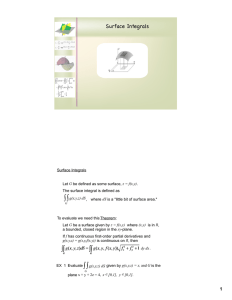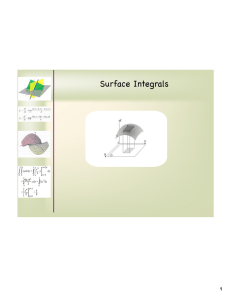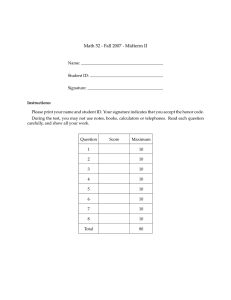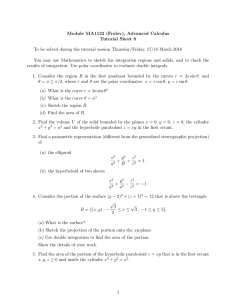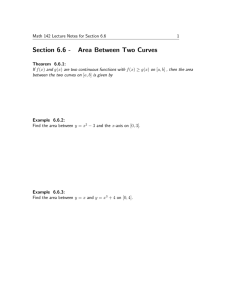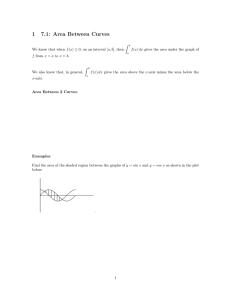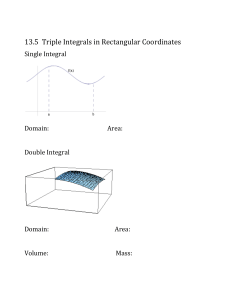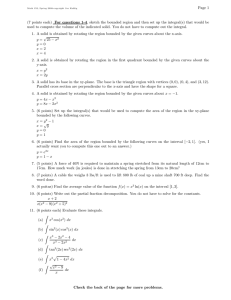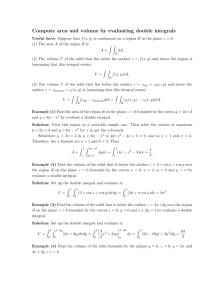Math 52 - Winter 2007 - Final Exam
advertisement
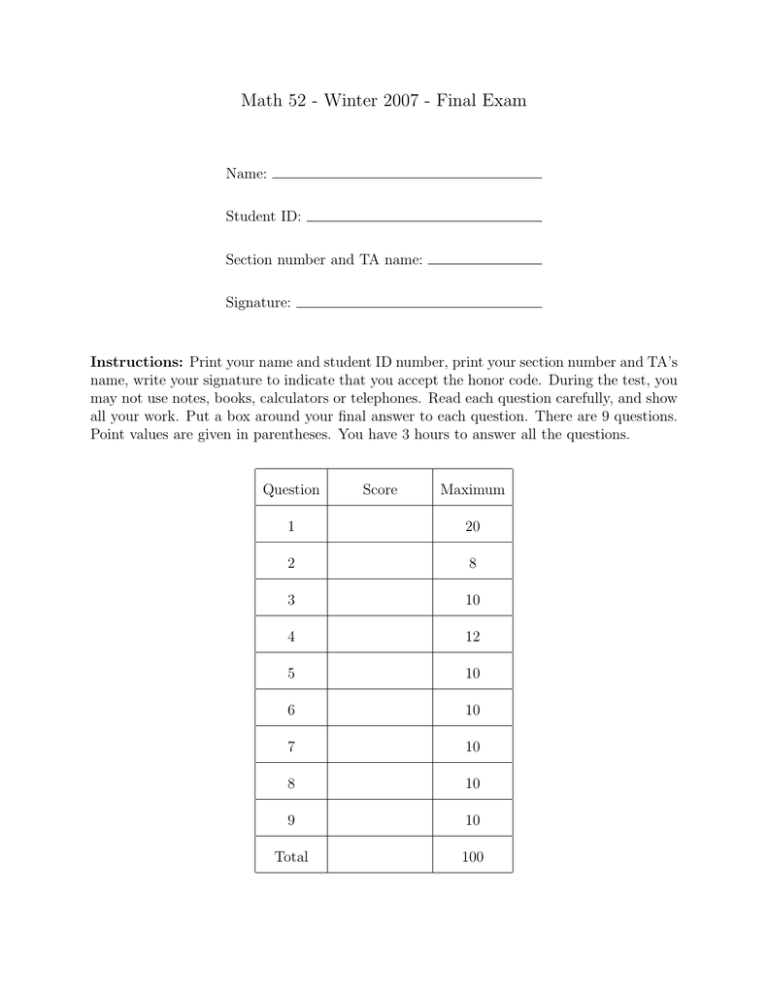
Math 52 - Winter 2007 - Final Exam Name: Student ID: Section number and TA name: Signature: Instructions: Print your name and student ID number, print your section number and TA’s name, write your signature to indicate that you accept the honor code. During the test, you may not use notes, books, calculators or telephones. Read each question carefully, and show all your work. Put a box around your final answer to each question. There are 9 questions. Point values are given in parentheses. You have 3 hours to answer all the questions. Question Score Maximum 1 20 2 8 3 10 4 12 5 10 6 10 7 10 8 10 9 10 Total 100 Problem 1. Mark the statements below as TRUE or FALSE. Each correct answer: +2 pts. Each wrong or missing answer: 0 pt. In all the statements below, 1) the letter f denotes a scalar field, three times differentiable where it is defined; 2) the letter F denotes a vector field, twice differentiable where it is defined; 3) the letter D denotes a bounded region in R3 , whose boundary ∂D is the union of finitely many closed, smooth, oriented surfaces with normal n pointing away from D (these assumptions allow to use Gauss’s theorem); and 4) the letter S denotes a smooth oriented surface S, whose boundary ∂S is the union of finitely many C 1 , simple, closed curves oriented consistently with S (these assumptions allow to use Stokes’s theorem). 1. If F is defined in D, there always exists f such that F = ∇f in D. TRUE FALSE. 2. If f is defined in D, there always exists F such that F = ∇f in D. TRUE FALSE. 3. If f is defined in D, there always exists F such that f = ∇ · F in D. TRUE FALSE. 4. If F is defined on S, and ∇ × F = 0 on S, then the line integral of F along any C 1 , simple, closed curve in S is always zero. TRUE FALSE. 5. If F is defined in R3 , then the line integral of ∇ × F along ∂S is always zero. TRUE FALSE. 6. If f is defined in R3 , then the line integral of ∇f along ∂S is always zero. TRUE FALSE. 7. If F is constant (not depending on x, y, z), then the flux of F through ∂D is always zero. TRUE FALSE. 8. If F is defined in R3 , and ∇ · F = 1 in D, then the flux of F through ∂D always equals the surface area of ∂D. TRUE FALSE. 9. If F is defined in R3 , then the flux of ∇ × F through ∂D is always zero. TRUE FALSE. 10. If f is defined in R3 , then the flux of ∇f through ∂D is always zero. TRUE FALSE. 1 Problem 2. Let C be the cone with parametric equation (r cos t, r sin t, r) with 0 ≤ r ≤ 3 and 0 ≤ t ≤ 2π. a) (4 points) For what order of parameters t and r will the cone parametrized with the above formula be oriented with the normal pointing away from the z axis. b) (4 points) Introduce an additional parameter 0 ≤ s ≤ 1 to parametrize a solid bounded by the above cone and the plane z = 3. (Your answer will be a formula X(s, t, r).) 2 Problem 3. Let T be the solid bounded by the paraboloids z = 8 − x2 − y 2 and z = x2 + y 2 . Set up, BUT DO NOT EVALUATE, an iterated triple integral that represents the volume of T a) (5 points) Viewing T as z-simple. b) (5 points) Viewing T as x-simple. 3 Problem 4. Let F(x, y, z) = 1 1 1 , , x y z . a) (4 points) Find a potential for F in the first octant (x > 0, y > 0, z > 0), or show that F is not conservative in the first octant. R b) (4 points) Show that C F · ds = 0 where C is any simple, C 1 curve whose endpoints belong to the surface S inside the first octant and satisfying the equation xyz = 4. c) (4 points) Find a potential for F in the second octant (x < 0, y > 0, z > 0), or show that F is not conservative in the second octant. 4 Problem 5. (10 points) Let S be the surface given by the parametrization 2 X(t, r) = r cos t, r sin t, er for 0 ≤ r ≤ 2 and 0 ≤ t ≤ 2π. Find ZZ F · dS S for F = (2x, −y, −z). Warning 1: S is not a closed surface! Warning 2: The parametrization X(t, r) defines an orientation of S. 5 2 2 Problem 6. Let C1 be the ellipse x25 + y9 = 1 and C2 be the unit circle x2 + y 2 = 1, both oriented counter-clockwise. Let F = yi + 2xj. H H 1. (5 points) Show that F · n ds = F · n ds, where n is the outer unit normal (in the C1 C2 plane!) of the respective curves. H H 2. (5 points) Show that F · T ds 6= F · T ds, where T is the unit tangent vector to C1 C2 the respective curves. 6 Problem 7. (10 points) Find the area of the region in the first quadrant of R2 that is bounded by the curves: xy = a2 , xy = 2a2 , y = x, 7 and y = 2x. Problem 8. (10 points) Let C be the circle in the plane 2x + y − z = 0, centered at (1, 1, 3), with radius 3. Let n be the normal vector to the plane 2x + y − z = 0 pointing up. Suppose C is oriented so that H T × n points inside the disk in the plane 2x + y − z = 0 bounded by the circle C. Find F · Tds, where F(x, y, z) = (z, x, y). C Hint: Use Stokes’s theorem. 8 Problem 9. (10 points) Let S be the surface defined as the graph of a function g(x, y) ≥ 0 of class C 1 , over the base domain D in the xy−plane, and oriented such that the normal points up. Let F = (0, RR0, 1). Prove that, regardless of the choice of g satisfying the above assumptions, the flux S F · dS is always the same, and equals the area of D. 9
